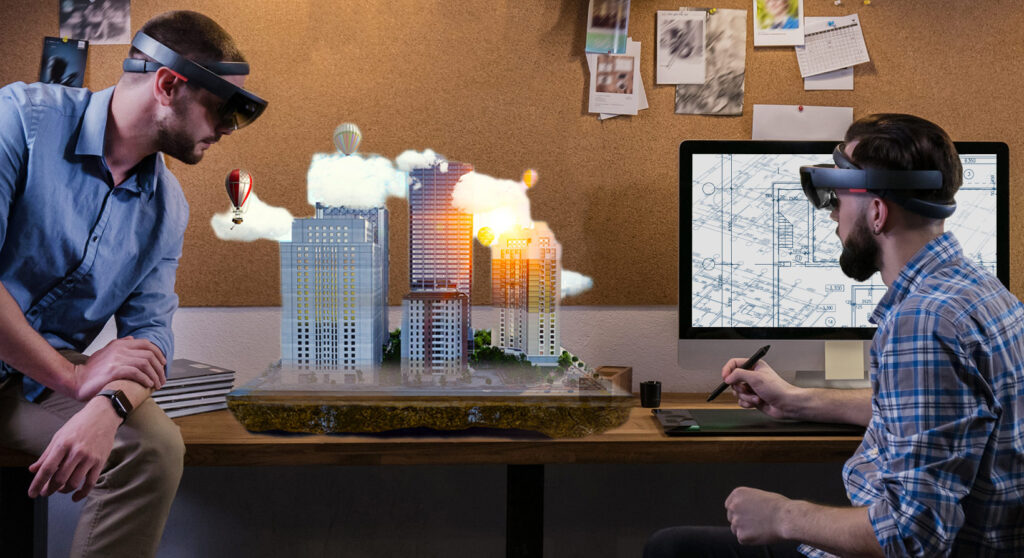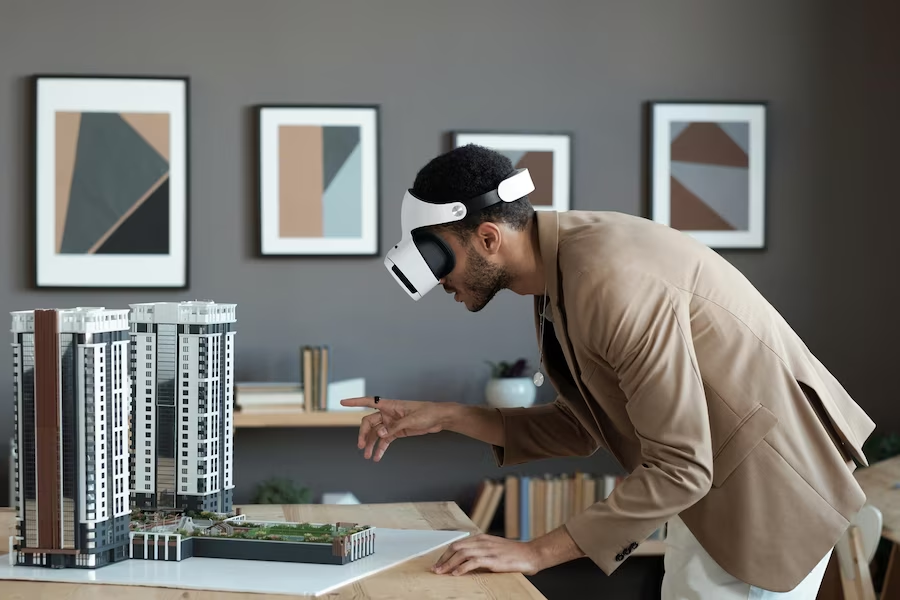
The convergence of interior design and technology has yielded revolutionary breakthroughs in recent times. Virtual reality (VR) is one of these that is particularly disruptive, transforming the interior design industry. Virtual reality (VR) is changing how designers and clients envision and create spaces in India, a nation renowned for its rich cultural legacy and quickly expanding tech sector. This article explores the advantages, difficulties, and potential applications of virtual reality for the Indian interior design market.
The Emergence of VR in Interior Design
By creating a simulated environment, virtual reality technology enables users to fully immerse themselves in an interactive, three-dimensional world. Virtual reality (VR) in interior design allows designers and clients to see spaces before they are built. Due to the growing need for unique and creative design solutions, this technology has become very popular in India.
Leading the way in incorporating virtual reality (VR) into their operations are Indian tech startups, interior design firms, and educational establishments. The nation’s increasing population of tech-savvy individuals and the accessibility of reasonably priced virtual reality hardware and software are driving this adoption. VR has changed the game for the better in the Indian interior design sector as a result of these factors coming together.
Benefits of VR in Interior Design
Enhanced Visualization and Client Engagement
One of the primary advantages of VR in interior design is its ability to provide enhanced visualization. Traditional design methods, such as sketches and two-dimensional renderings, often fall short in conveying the true essence of a space. VR, on the other hand, offers a lifelike experience, allowing clients to walk through their future homes or offices and get a realistic sense of the scale, layout, and aesthetics.
This immersive experience significantly improves client engagement. Clients can explore different design options, make real-time changes, and visualize the final outcome with greater clarity. This level of interactivity fosters better communication between designers and clients, leading to more informed decision-making and higher client satisfaction.
Time and Cost Efficiency
VR integration into the design process can result in significant time and money savings. By providing clients with a virtual experience of the design, possible problems can be found and fixed early on. This lessens the possibility of pricey changes and delays when building is underway. Moreover, virtual reality (VR) enhances the design process by enabling designers to test out different materials and design elements without having to pay for physical samples.
Individualization and Tailoring
Indian customers are looking for more individualized and distinctive design solutions that suit their own preferences and tastes. By enabling customers to see various design philosophies, color palettes, furniture configurations, and lighting options, virtual reality (VR) enables designers to provide extremely personalized experiences. This degree of personalization guarantees that the finished design precisely reflects the client’s vision, increasing overall project satisfaction.
Challenges and Limitations
While VR offers numerous benefits, its adoption in the Indian interior design industry is not without challenges. Some of the key limitations include:
High Initial Investment
Implementing VR technology requires a significant initial investment in hardware, software, and training. High-quality VR headsets, powerful computers, and specialized software can be costly, posing a barrier for smaller design firms and individual designers. However, as technology advances and becomes more affordable, this barrier is expected to diminish over time.
Technical Expertise
To fully leverage the potential of VR, designers need to acquire technical skills and expertise in using VR software and tools. This necessitates continuous learning and training, which can be time-consuming and resource-intensive. Collaboration with tech professionals and investing in skill development programs can help bridge this gap.
Client Adaptability
While younger, tech-savvy clients readily embrace VR technology, older clients may be less comfortable with its use. Designers need to balance traditional and modern approaches, ensuring that all clients, regardless of their technological proficiency, can benefit from the design process. Providing comprehensive demonstrations and user-friendly interfaces can help in overcoming this challenge.
Case Studies: VR in Action
Several Indian interior design firms and projects have successfully integrated VR into their workflows, showcasing its transformative potential.

Studio Symbiosis: Redefining Luxury Residences
Studio Symbiosis, a leading architectural and interior design firm based in New Delhi, has been a pioneer in adopting VR technology. For a recent luxury residential project, the firm used VR to present multiple design iterations to the client. The immersive experience allowed the client to explore different layouts, materials, and lighting options, leading to a final design that exceeded their expectations. The use of VR not only enhanced client engagement but also streamlined the decision-making process, resulting in a more efficient and satisfactory project completion.
Livspace: Transforming Home Interiors
Livspace, a prominent online interior design platform, has integrated VR into its service offerings to enhance the customer experience. By providing VR-enabled design consultations, Livspace allows clients to virtually tour their future homes and make real-time modifications. This approach has proven particularly effective in the Indian market, where clients value the ability to visualize their investments before committing to them. Livspace’s VR integration has led to increased customer satisfaction and a competitive edge in the crowded online interior design space.
The Future of VR in Indian Interior Design
The future of VR in the Indian interior design industry looks promising, with several trends and developments on the horizon.
Integration with Augmented Reality (AR)
The combination of VR and Augmented Reality (AR) holds immense potential for the interior design industry. While VR provides an immersive experience, AR allows users to overlay digital elements onto the real world. This integration can enable clients to visualize how specific design elements, such as furniture or decor, will look in their existing spaces. The seamless blending of virtual and real environments will further enhance the design experience and expand the possibilities for customization.
Collaboration and Remote Design
As remote work and collaboration become more prevalent, VR offers a powerful solution for designers and clients to collaborate from different locations. VR enables virtual design meetings, walkthroughs, and presentations, eliminating the need for physical presence. This flexibility is particularly valuable in a diverse and geographically vast country like India, where clients and designers may be located in different cities or regions.
Sustainable and Eco-Friendly Design
Sustainability is a growing concern in the interior design industry, and VR can play a significant role in promoting eco-friendly practices. By simulating different design scenarios, VR allows designers to evaluate the environmental impact of their choices, such as energy efficiency, material usage, and waste reduction. This aligns with the increasing demand for sustainable design solutions in India and contributes to a greener future.
In conclusion
Without a doubt, virtual reality is completely changing interior design in India. Both designers and clients can benefit from its capacity to offer immersive visualization, improve client engagement, and expedite the design process. Although there are still obstacles to overcome, the continued development of technology and the increasing popularity of virtual reality point to a promising future for its incorporation into the Indian interior design sector. VR promises to open up new possibilities for creativity, efficiency, and personalization as it develops, influencing interior design in India going forward.